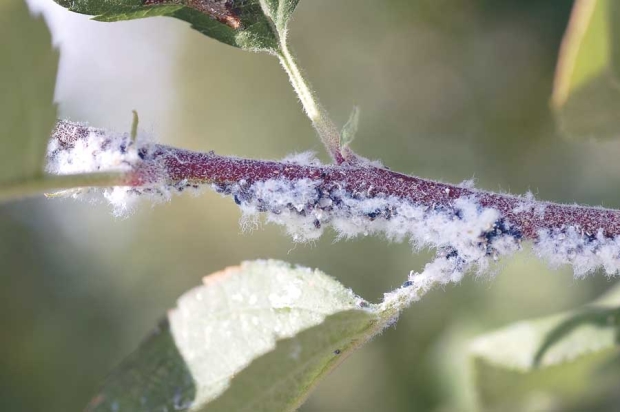
Woolly apple aphids, a pest that lives both in trees and underground, is increasing in Washington orchards. The aphids leave behind tell-tale waxy fibers that resemble wool. (Courtesy of Robert Opert, TFREC)
The woolly aphid, a plant-sucking pest that produces waxy fibers resembling wool or cotton, is surging in Washington, evading the few available pesticides by living in both trees and soil and leaving researchers scratching their heads about what to do.
“In the past 10 or so years, we’ve had an increase in problems with the woolly apple aphid,” Robert Orpet, a Washington State University graduate student, told growers in January at the North Central Washington Apple Day in Wenatchee, Washington.
Like most researchers, Orpet admitted he has no silver bullet, but he advised growers to consider planting aphid-resistant Geneva rootstocks, to use caution while grafting, to spray Ultor (spirotetramat) when necessary and, perhaps, to preserve their earwigs.
Ultor applied to a tree kills woolly aphids both on the branches and down to the roots, but growers often don’t know when trees are infected if bugs are underground. Pruning away infected branches only sends the insects scurrying to the ground to hide.
Heavy root infestations can cause yield losses up to 5 percent, Orpet said, and the pests quickly attack grafting points, as well as winter damage or pruning wounds.
Most of the damage is long-term to the trees, but when they’re really bad, they leave in their wake a waste that sometimes attracts sooty mold, a black fungus that builds up in the stem of the fruit.
“It’s becoming a major pest for us, and we’re looking for answers,” said Tim Welsh, general manager of new variety and orchard development for Columbia Fruit Packers in Wenatchee, Washington.
Using grants from the Washington State Department of Agriculture and the Washington Tree Fruit Research Commission, Orpet spent two years surveying woolly aphid populations in 20 central Washington orchards, some of them Welsh’s, while interviewing orchardists about management techniques and sampling for other characteristics such as soil nutrition, other bugs and cankers.
He found few correlations. They seemed to thrive equally in both organic and conventional orchards regardless of soil quality, nitrogen levels and the presence or lack of perennial cankers.
However, a few things stood out in his research, which will continue into 2016.
One, sandy soil seems to hold them back. Sand, more fluid than loam, fills in cracks in the ground and may prevent the woolly aphids from moving around as freely. The three sites he surveyed with low woolly aphid populations had a high percentage of sandy soil. Earlier studies have come to the same conclusion, he said.
Two, the earwig might be an “underappreciated” natural predator, he said.
Presence of the earwig, an omnivore sometimes considered a minor pest in and of itself, seemed to dampen the population of woolly aphids. Woolly aphids tend to surge in the spring, fall back in the summer with temperatures over 90 degrees and resurge in the fall.
But orchards Orpet surveyed with a lot of earwigs didn’t have nearly as many woolly aphids in the fall as those with few earwigs.
In the future, Orpet aims to conduct trials with different mulches to mimic the benefits of sand and conduct DNA testing on earwig guts to find out what they eat — specifically, if woolly aphids were on the menu.
In the meantime, he asked growers to consider earwig conservation efforts like cutting back on the use of Sevin (carbaryl) and Success or Entrust (spinosad), which are both toxic to earwigs. •
– by Ross Courtney






Leave A Comment